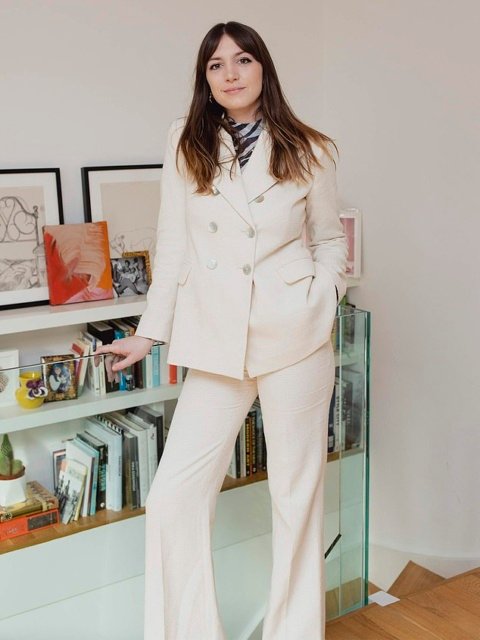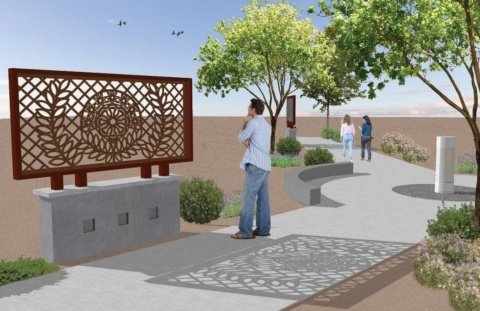Spanning a wide array of media, from ceramic, stone, textile, wood, bronze and Corten steel to paintings on silk, paper or canvas, Algerian artist Rachid Koraïchi’s work has been exhibited at the Venice Biennale and New York’s Museum of Modern Art, and is collected by major institutions including the British Museum in London, Miami Art Museum, Guggenheim Abu Dhabi, National Gallery in Amman and Kiran Nadar Museum of Art in New Delhi. In 2011, seven of his 99 banners from “The Invisible Masters” won the Victoria and Albert Museum’s Jameel Prize, in partnership with Art Jameel. Like the nomadic migrations of his ancestors that were regarded as spiritual advancements, his art is executed in multiple locations worldwide, including France, Algeria, Tunisia, Egypt and Spain, in collaboration with master artisans specializing in age-old crafts or the most avant-garde techniques.
Banners from The Invisible Masters series by Rachid Koraïchi
You work with a wide variety of materials. Tell me about the artisans you work with.
First of all, we’re going to go back to the beginning of history because Islamic civilization, what it shows today in the 21st century, is precisely all this work of the “artisans”. But don’t forget that the first part of the word “artisans” is “art”. So it’s important not to underestimate the esthetic aspect because we’re not normally allowed to do figurative work. Figuration, even if I did some in my apprenticeships at the Ecole des Beaux-Arts in Algiers and in Paris and at the Ecole des Arts Décoratifs in Paris, is an art of symbolism, an art of geometry, an art of minimalism because you have to say things that you can’t say directly, you have to suggest them. And then, you mustn’t forget that I live on the African continent. Let’s not forget that Picasso, Braque, Klee, Matisse and others became the world’s greatest artists we know thanks to Africa. Picasso found cubism when he saw African masks, Matisse when he traveled to North Africa and so on, but when we work on what we know how to do best, we’re immediately labeled ethnic artists or folklore. We’re plundered of our culture, like colonization, and we’re told, “No, you’re natives, stay where you are. We’re the cultural greats.” It’s also Neo-colonialism. Picasso was a militant, a man of the left. He did it for beauty’s sake, to say that Africa exists, that it’s strong, but in the West, the way collectors, museums and galleries look at it is unfortunately in this way.
Can you explain further?
Look at the number of African art galleries, the hangars crammed to the rafters with African art, the foundation museums crammed with African art that has been looted from this continent and is still giving. This continent has never stopped this torrent of art, an absolute non-stop torrent. It gives instead of taking, and it continues doing so. I think it’s this extraordinary thing that we need to open people’s eyes to. Exhibition visitors need to always bear in mind that even on the labels in museums, we see the collector’s name, but never the name of the African artist or the African tribe, whether it’s Nigeria, Sierra Leone or Gabon. These are things that people don’t think about. It’s not nothing; it’s huge. And it’s in this sense that I say that when I work with artisans, it’s not accidental.
Rachid Koraïchi collaborates with an artisan on the series The Invisible Masters
So it’s a carefully considered choice…
They’re first and foremost artists, and I always take the best of the best, with whom I can progress and who become a family, a brotherhood. For example, I have a studio that I’ve been renting for years in Cairo, where I did my major project “The Invisible Masters”, for which I won the Jameel Prize. I’ve worked for years with the best embroiderers, the best silks from Damascus to Aleppo. I’ve even worked in Michigan, on porcelain, I’ve worked in Iznik, I’ve worked in Cappadocia, in Turkey, on porcelain, in old churches that have become superb porcelain workshops. I’ve also worked for years at Factum Arte in Madrid, where a friend, Adam Lowe, has set up a superb workshop using the most advanced techniques, so there’s always work by Anish Kapoor, Abramović, myself, etc. in the same workshop. In Barcelona, it’s porcelain, ceramics, it’s two very dear friends who are great porcelain ceramists. I’m thinking of Mathilde de Grau, I’m also thinking of Marc Vidal, who are teachers at the Massana School and the School of Arts and Crafts, so it’s not an old-fashioned craftsman thing, it’s also very contemporary, people who have powerful working techniques.
Do you only work with artisans who are at the top of their craft?
Absolutely. The stitching is better than Hermès, the sculpture work is better than the best you can imagine. It costs me a lot, it’s true, because I finance my work myself. I sell it for very little deliberately so that when I show it in a foundation or in a museum, that’s when the eye rests on the piece. I’m not a navel-gazer, even at my studio. My walls are white, there isn’t a work of mine. If there is a work, it’s already packed, closed and turns its back on the viewer because the space has to be in silence, so that I don’t have any color that disturbs my reflection or the creation of something. It’s exactly like an orchestra conductor when he goes to the opera or the conservatory, he waits for absolute silence: no throat clearing, no coughing, no moving of chairs. When there’s silence, he starts the music at that moment, in absolute silence. As for me, in absolute silence, I start my work.
Rachid Koraïchi, Les Maîtres du Temps, 2018, oxide on white clay, 27 x 27 cm



